370. Schalow's Turaco Tauraco schalowi
ORDER MUSOPHAGIFORMES. Family Musophagidae
Description
41–44 cm; male 236–261 g, female 208–267 g. Large, predominantly green turaco. Similar to T. livingstonii, best identified by very long, white-tipped, floppy forward-pointing crest. Also has a bright red bill, and a hhort white line above and a longer one below and behind the red-ringed eyes. Wings green washed blue, tail dark glossed prurple-black. Their wings are short and round with red flight feathers meant for short flights.
Distribution
Occurs from western Angola and southern DRC to Tanzania, Zambia, the Caprivi Strip (Namibia) and northern Botswana.
Movements and migrations
Resident and largely sedentary, although it may occasionally make nomadic movements.
Habitat
Lowland evergreen forest.
Diet
Mainly eats fruit, doing most of its foraging in the forest canopy and understorey.
Breeding
Monogamous, territorial solitary nester, its nest is yet to be described, although it is known that it can be placed quite high up in a tree. Egg-laying season is from September-February in Zambia and Malawi. It lays 1-2 eggs, which are incubated by both sexes for about 20-22 days. The chicks leave the nest at about 25-28 days old; within two weeks they have learnt to fly and are feeding for themselves, becoming fully independent at about 53 days old.
Status
Locally common resident.
Africa Wild Bird Book
-
Klipspringer
- Global Moderator
- Posts: 5862
- Joined: Sat Sep 14, 2013 12:34 pm
- Country: Germany
- Contact:
-
Klipspringer
- Global Moderator
- Posts: 5862
- Joined: Sat Sep 14, 2013 12:34 pm
- Country: Germany
- Contact:
-
Duke
Knysna Turaco
370. Knysna Turaco (formerly known as Knysna Lourie) Tauraco corythaix
ORDER MUSOPHAGIFORMES. Family Musophagidae
Description
A large turaco, 40-42 cm from beak to tail, 260-380 g.
The Knysna Turaco has a sharply curved short but thick orange-red bill and a white line just under the eye that contrast with its mainly green plumage. It has a tall green crest, which is tipped with white. The eye is brown and the eye-ring deep red. In flight, Knysna Turaco shows conspicuous red primary flight feathers. Sexes are similar.
Juveniles have a shorter crest that lacks the white tips.
Similar Species: The all-green head, white stripe below the eye and white tips to the crest distinguish this species from Purple-crested Turaco. The Knysna, Livingstone's and Schalow's Turacos are very similar and may collectively be referred to as the 'green turacos'. The Livingstone's Turaco has a taller, pointed crest. The ranges of the Knysna turaco and the similar Livingstone's Turaco do not overlap so confusion between them should not arise. The easiest way to identify it from other green turacos is by the white tip on its rounded crest.
Distribution
Found almost exclusively in South Africa, in the narrow strip of forest extending from Mpumalanga, through KwaZulu-Natal, Eastern and Western Cape provinces. Can be found also in Mozambique and Swaziland, though, with an estimated global extent of occurrence of 20 000-50 000 km, though most of its population is concentrated in coastal Eastern Cape and KwaZulu-Natal.
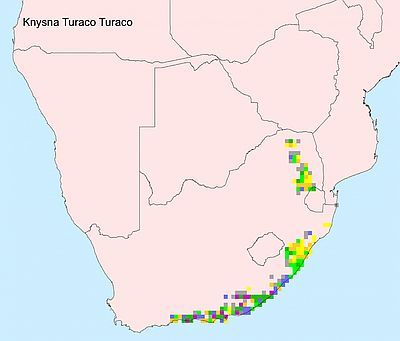
Habitat
A species of the indigenous Cape coastal forest, it generally prefers Afromontane forest and riverine forest in fynbos. It is usually seen flying between forest trees, or hopping with agility along branches.
Diet
It feeds mainly on fruits and berries, with seeds, leaves, insects, and earthworms making up the rest of its diet.
Breeding
It nests at different times of the year, depending on the region. Adults form monogamous pair bonds, and both parents contribute equally to incubation, brooding and feeding. Though social, Turacos nest solitarily. The nest is built by both sexes, and is a flimsy platform of twigs, placed in thick tangles of leaves in a tree or in dense creepers. The female lays 1-2 eggs, which are incubated by both sexes, for 20-24 days. The chicks stay in the nest for about 22 days, after which they clamber around the surrounding branches. They attempt their first flight at about 28 days, becoming independent a few week after this. Adults feed their chicks predigested fruit. Young birds take about a year to develop full adult coloration. Juvenile birds have a shorter crest without the white tips.
Call
It has a loud kow-kow-kow-kow call.
Status
Common, localised resident. Turacos are social, moving in small, noisy flocks.
The global population size has not been quantified, but the species is not believed to approach the thresholds for population size criterion of the IUCN Red List (i.e. less than 10 000 mature individuals). Global population trends have likewise not been quantified, but populations appear to be stable so the species is not believed to approach the thresholds for the population decline criterion of the IUCN Red List (i.e. declining more than 30% in ten years or three generations). For these reasons, the species is evaluated as Least Concern. According to the CITES II, it is not globally threatened, but future population projections indicate it will be affected by coastal deforestation.
ORDER MUSOPHAGIFORMES. Family Musophagidae
Description
A large turaco, 40-42 cm from beak to tail, 260-380 g.
The Knysna Turaco has a sharply curved short but thick orange-red bill and a white line just under the eye that contrast with its mainly green plumage. It has a tall green crest, which is tipped with white. The eye is brown and the eye-ring deep red. In flight, Knysna Turaco shows conspicuous red primary flight feathers. Sexes are similar.
Juveniles have a shorter crest that lacks the white tips.
Similar Species: The all-green head, white stripe below the eye and white tips to the crest distinguish this species from Purple-crested Turaco. The Knysna, Livingstone's and Schalow's Turacos are very similar and may collectively be referred to as the 'green turacos'. The Livingstone's Turaco has a taller, pointed crest. The ranges of the Knysna turaco and the similar Livingstone's Turaco do not overlap so confusion between them should not arise. The easiest way to identify it from other green turacos is by the white tip on its rounded crest.
Distribution
Found almost exclusively in South Africa, in the narrow strip of forest extending from Mpumalanga, through KwaZulu-Natal, Eastern and Western Cape provinces. Can be found also in Mozambique and Swaziland, though, with an estimated global extent of occurrence of 20 000-50 000 km, though most of its population is concentrated in coastal Eastern Cape and KwaZulu-Natal.

Habitat
A species of the indigenous Cape coastal forest, it generally prefers Afromontane forest and riverine forest in fynbos. It is usually seen flying between forest trees, or hopping with agility along branches.
Diet
It feeds mainly on fruits and berries, with seeds, leaves, insects, and earthworms making up the rest of its diet.
Breeding
It nests at different times of the year, depending on the region. Adults form monogamous pair bonds, and both parents contribute equally to incubation, brooding and feeding. Though social, Turacos nest solitarily. The nest is built by both sexes, and is a flimsy platform of twigs, placed in thick tangles of leaves in a tree or in dense creepers. The female lays 1-2 eggs, which are incubated by both sexes, for 20-24 days. The chicks stay in the nest for about 22 days, after which they clamber around the surrounding branches. They attempt their first flight at about 28 days, becoming independent a few week after this. Adults feed their chicks predigested fruit. Young birds take about a year to develop full adult coloration. Juvenile birds have a shorter crest without the white tips.
Call
It has a loud kow-kow-kow-kow call.
Status
Common, localised resident. Turacos are social, moving in small, noisy flocks.
The global population size has not been quantified, but the species is not believed to approach the thresholds for population size criterion of the IUCN Red List (i.e. less than 10 000 mature individuals). Global population trends have likewise not been quantified, but populations appear to be stable so the species is not believed to approach the thresholds for the population decline criterion of the IUCN Red List (i.e. declining more than 30% in ten years or three generations). For these reasons, the species is evaluated as Least Concern. According to the CITES II, it is not globally threatened, but future population projections indicate it will be affected by coastal deforestation.
Last edited by Duke on Mon May 19, 2014 3:27 pm, edited 1 time in total.
-
Duke
Knysna Turaco Photos
370. Knysna Turaco Tauraco corythaix
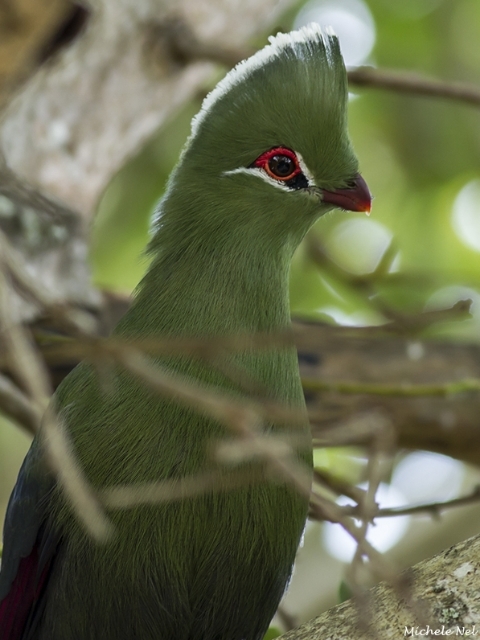 © Michele Nel
© Michele Nel
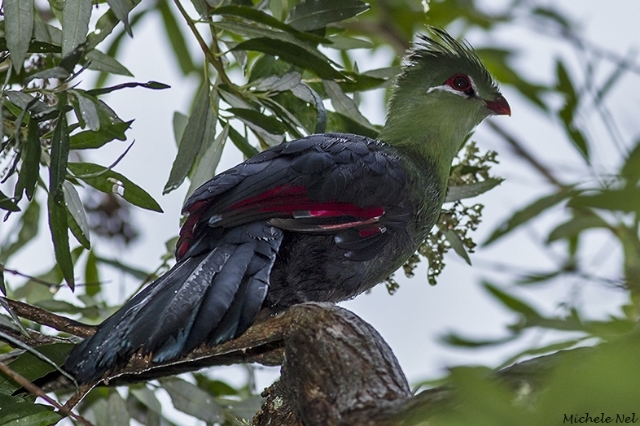 © Michele Nel
© Michele Nel
Garden Route National Park, Wilderness, Ebb and Flow
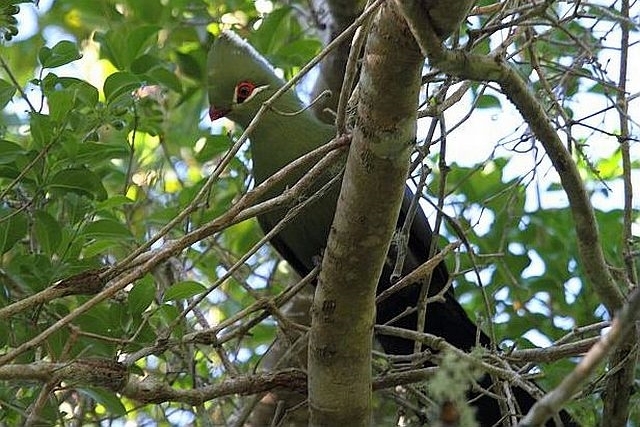 © Duke
© Duke

Garden Port Elizabeth © PJL
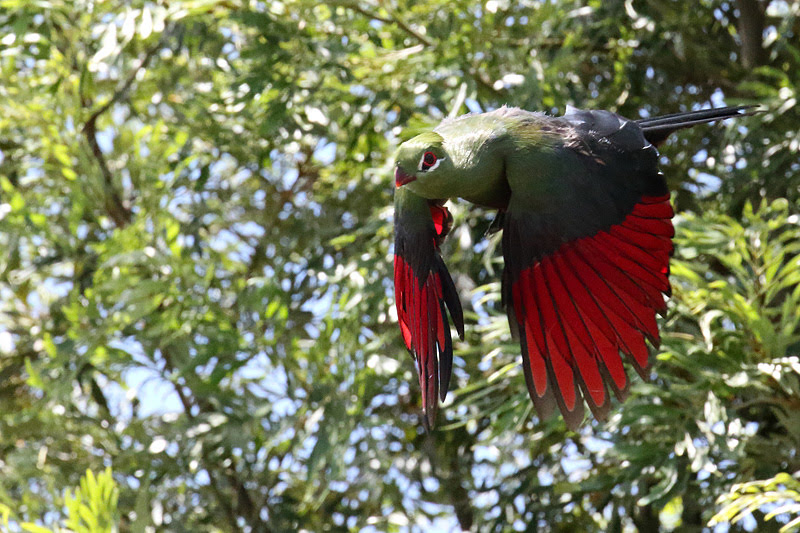
Garden Port Elizabeth © PJL
Did you know: Turacos (the 10 species of the Tauraco and the 2 of the Musophaga) are the only birds to possess true red and green color. When you look at most birds, the color you are seeing is a reflection produced by the feather structure. The Turaco's red pigment (turacin) and green pigment (turacoverdin) both contain copper. In fact, if you stirred a glass of water with a red turaco feather, the water would turn pink! In museum species, the pigments deepen with age because the copper begins to oxidize. These birds mannage to maintain their colors throughout the year. The Knysna Turaco is thought to use its red wing feathers to escape predators. Indeed, when it flies, the predators tend to focus on the most visible color and follow the red patch. As the Lourie bird and folds its wings, the red feathers of the wings become invisible and the Turaco has a chance of escaping unseen.
Links:
Species text Sabap1: http://sabap2.adu.org.za/docs/sabap1/370.pdf
Sabap2
Ian Sinclair: Southern African Birds: A Photographic Guide
Newman's Birds of Southern Africa
Biodiversity Explorer: http://www.biodiversityexplorer.org/bir ... ythaix.htm
 © Michele Nel
© Michele Nel © Michele Nel
© Michele NelGarden Route National Park, Wilderness, Ebb and Flow
 © Duke
© DukeGarden Port Elizabeth © PJL
Garden Port Elizabeth © PJL
Did you know: Turacos (the 10 species of the Tauraco and the 2 of the Musophaga) are the only birds to possess true red and green color. When you look at most birds, the color you are seeing is a reflection produced by the feather structure. The Turaco's red pigment (turacin) and green pigment (turacoverdin) both contain copper. In fact, if you stirred a glass of water with a red turaco feather, the water would turn pink! In museum species, the pigments deepen with age because the copper begins to oxidize. These birds mannage to maintain their colors throughout the year. The Knysna Turaco is thought to use its red wing feathers to escape predators. Indeed, when it flies, the predators tend to focus on the most visible color and follow the red patch. As the Lourie bird and folds its wings, the red feathers of the wings become invisible and the Turaco has a chance of escaping unseen.
Links:
Species text Sabap1: http://sabap2.adu.org.za/docs/sabap1/370.pdf
Sabap2
Ian Sinclair: Southern African Birds: A Photographic Guide
Newman's Birds of Southern Africa
Biodiversity Explorer: http://www.biodiversityexplorer.org/bir ... ythaix.htm
Last edited by Duke on Mon May 19, 2014 3:29 pm, edited 1 time in total.
Purple-crested Turaco
371. Purple-crested Turaco (fomerly known as Purple-crested Lourie) Tauraco porphyreolophus (Bloukuifloerie)
ORDER MUSOPHAGIFORMES. Family: Musophagidae
Description
The Purple-crested Turaco has a height of 45 cm and weighs around 300 g.
The adult has green washed rose-pink upper back and breast. Lower back and wing-coverts are greyish-blue, except the lesser wing-coverts. The rump is dull blue-black. Uppertail-coverts, tail and inner secondaries are glossy violet-blue washed green. Primary and outer secondary flight feathers are crimson with dark brown edges and tips. On the underparts, the breast is green washed pink. Belly and thighs are pale bluish-grey. On the head, forehead, superciliary area, cheeks and ear-coverts are glossy green. Crown, rounded crest and nape are iridescent dark violet-purple. Lower cheeks, chin, throat and neck are olive-green. The bill is black. The eyes are dark brown, surrounded by scarlet bare eyering. Legs and feet are blackish-blue. Both adults are similar.
The juvenile is duller.
Distribution
It is found from Uganda and Tanzania to Mozambique, Zimbabwe, Swaziland and eastern South Africa.
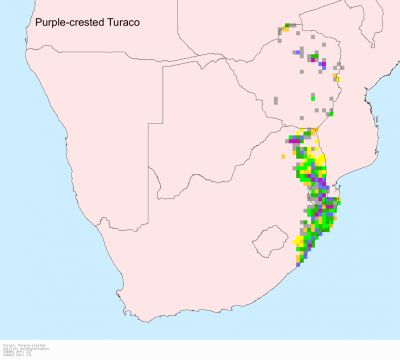
Habitat
It generally prefers closed woodland, particularly riverine woodland, although it also occupies thick scrub and coastal forest.
Diet
It eats mainly fruit, foraging in tree canopies, perching at the end of branches to pick the fruit directly.
Breeding
The nest is built by both sexes, with one collecting sticks and handing them to other, who adds them to the nest. It is typically placed in matted creepers, dense mistletoe or isolated thorn trees. Egg-laying season is from August-February. It lays 2-4 eggs, which are incubated by both sexes for 21-23 days. The chicks are brooded for the first week of their lives, after which brooding time progressively decreases. The chicks leave the nest before they can fly, at about 21 days old, taking their first flight approximately 17 days later.
Call
A series of croaking ko-ko-ko-ko-ko followed by a series of growling krr-krr-krr-krr. Listen to Bird Call.
Status
Locally common resident.
ORDER MUSOPHAGIFORMES. Family: Musophagidae
Description
The Purple-crested Turaco has a height of 45 cm and weighs around 300 g.
The adult has green washed rose-pink upper back and breast. Lower back and wing-coverts are greyish-blue, except the lesser wing-coverts. The rump is dull blue-black. Uppertail-coverts, tail and inner secondaries are glossy violet-blue washed green. Primary and outer secondary flight feathers are crimson with dark brown edges and tips. On the underparts, the breast is green washed pink. Belly and thighs are pale bluish-grey. On the head, forehead, superciliary area, cheeks and ear-coverts are glossy green. Crown, rounded crest and nape are iridescent dark violet-purple. Lower cheeks, chin, throat and neck are olive-green. The bill is black. The eyes are dark brown, surrounded by scarlet bare eyering. Legs and feet are blackish-blue. Both adults are similar.
The juvenile is duller.
Distribution
It is found from Uganda and Tanzania to Mozambique, Zimbabwe, Swaziland and eastern South Africa.

Habitat
It generally prefers closed woodland, particularly riverine woodland, although it also occupies thick scrub and coastal forest.
Diet
It eats mainly fruit, foraging in tree canopies, perching at the end of branches to pick the fruit directly.
Breeding
The nest is built by both sexes, with one collecting sticks and handing them to other, who adds them to the nest. It is typically placed in matted creepers, dense mistletoe or isolated thorn trees. Egg-laying season is from August-February. It lays 2-4 eggs, which are incubated by both sexes for 21-23 days. The chicks are brooded for the first week of their lives, after which brooding time progressively decreases. The chicks leave the nest before they can fly, at about 21 days old, taking their first flight approximately 17 days later.
Call
A series of croaking ko-ko-ko-ko-ko followed by a series of growling krr-krr-krr-krr. Listen to Bird Call.
Status
Locally common resident.
Purple-crested Turaco Photos
371. Purple-crested Turaco Tauraco porphyreolophus
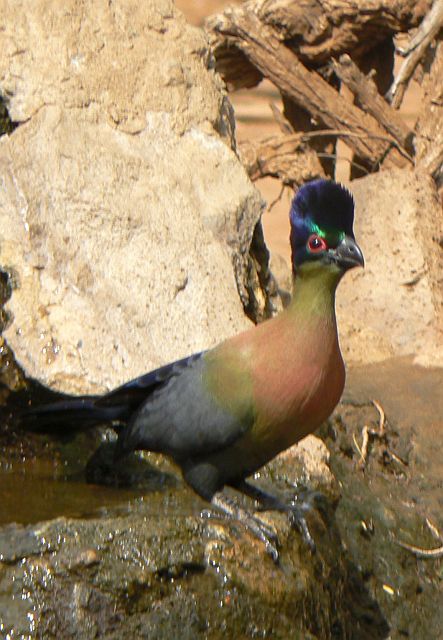 © Toko
© Toko
Mkuze Game Reserve, KwaZulu-Natal
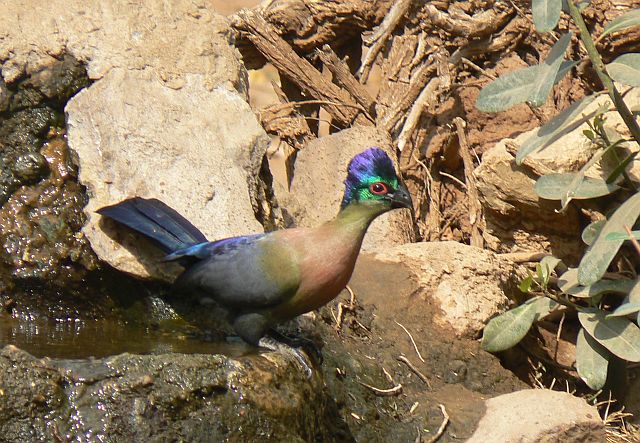 © Toko
© Toko
Mkuze Game Reserve, KwaZulu-Natal
 © Dewi
© Dewi
Kruger National Park, Mahonie Loop
 © The Cow
© The Cow
Kruger National Park, Skukuza
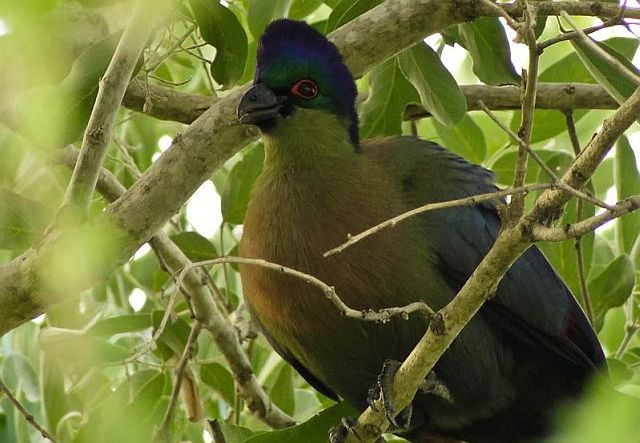 © JustN@ture
© JustN@ture
 © steamtrainfan
© steamtrainfan
The red wing feathers are conspicuous in flight.
 © BluTuna
© BluTuna
Kruger National Park
Links:
Species text Sabap1: http://sabap2.adu.org.za/docs/sabap1/371.pdf
Sabap2: http://sabap2.adu.org.za/species_info.p ... #menu_left
Roberts online
Oiseaux net: http://www.oiseaux-birds.com/card-purpl ... uraco.html
 © Toko
© TokoMkuze Game Reserve, KwaZulu-Natal
 © Toko
© TokoMkuze Game Reserve, KwaZulu-Natal
 © Dewi
© DewiKruger National Park, Mahonie Loop
 © The Cow
© The CowKruger National Park, Skukuza
 © JustN@ture
© JustN@ture © steamtrainfan
© steamtrainfanThe red wing feathers are conspicuous in flight.
 © BluTuna
© BluTunaKruger National Park
Links:
Species text Sabap1: http://sabap2.adu.org.za/docs/sabap1/371.pdf
Sabap2: http://sabap2.adu.org.za/species_info.p ... #menu_left
Roberts online
Oiseaux net: http://www.oiseaux-birds.com/card-purpl ... uraco.html
Grey Go-away Bird
373. Grey Go-away Bird (Formerly known as Grey Lourie) Corythaixoides concolor (Kwëvoël)
Order: Musophagiformes. Family: Musophagidae
Description
Length 47-50 cm, Weight 202-340 g.
Plumage is plain grey. Crown shows a wonderful slightly shaggy crest of about 6-7 cm in length, raised or flattened. Strong, short, decurved bill is black. Eyes are dark brown. Legs and feet are black.
Both sexes are similar. Juvenile has buffer plumage than adults, and shorter crest.
Distribution
Occurs from Zambia, Malawi and coastal Angola through to southern Africa, where it is common in northern and central Namibia, northern and eastern Botswana, Zimbabwe, Mozambique, Swaziland and north-eastern South Africa.
Habitat
It generally prefers dry savanna, broad-leaved Burkea (Burkea africana) woodland, dry riverine woodland and suburban gardens.
Diet
It eats mainly plant products, such as fruit, flowers, leaves and buds, supplemented with small invertebrates. It often forages in tree canopies, sometimes descending to the ground to feed on invertebrates and low-lying plants.
Breeding
The Grey go-away bird is monogamous and occasionally breeds with nest helpers. The nest is a flat, flimsy platform of interlaced twigs. It is typically placed 3-10m above ground in a thorny tree. Egg-laying season is year-round, peaking from September-October. It lays 1-4, usually 2-3 pale blue eggs which are incubated by both sexes for 26-29 days. The incubating bird is very difficult to scare out of its position. The chicks stay in the nest for 18-21 days, leaving before they can fly. At roughly 33 days old the chicks can feed themselves, learning to fly a few days later and becoming fully independent at about 41 days old.
Call
These birds are highly vocal when alarmed; their loud, nasal kwê or kwaa often alerts other wildlife of the approach of a predator. Listen to Bird Call.
Status
Common resident, mostly sedentary, forming flocks in non-breading season. Roosts in groups of 3-5 birds at night.
Order: Musophagiformes. Family: Musophagidae
Description
Length 47-50 cm, Weight 202-340 g.
Plumage is plain grey. Crown shows a wonderful slightly shaggy crest of about 6-7 cm in length, raised or flattened. Strong, short, decurved bill is black. Eyes are dark brown. Legs and feet are black.
Both sexes are similar. Juvenile has buffer plumage than adults, and shorter crest.
Distribution
Occurs from Zambia, Malawi and coastal Angola through to southern Africa, where it is common in northern and central Namibia, northern and eastern Botswana, Zimbabwe, Mozambique, Swaziland and north-eastern South Africa.
Habitat
It generally prefers dry savanna, broad-leaved Burkea (Burkea africana) woodland, dry riverine woodland and suburban gardens.
Diet
It eats mainly plant products, such as fruit, flowers, leaves and buds, supplemented with small invertebrates. It often forages in tree canopies, sometimes descending to the ground to feed on invertebrates and low-lying plants.
Breeding
The Grey go-away bird is monogamous and occasionally breeds with nest helpers. The nest is a flat, flimsy platform of interlaced twigs. It is typically placed 3-10m above ground in a thorny tree. Egg-laying season is year-round, peaking from September-October. It lays 1-4, usually 2-3 pale blue eggs which are incubated by both sexes for 26-29 days. The incubating bird is very difficult to scare out of its position. The chicks stay in the nest for 18-21 days, leaving before they can fly. At roughly 33 days old the chicks can feed themselves, learning to fly a few days later and becoming fully independent at about 41 days old.
Call
These birds are highly vocal when alarmed; their loud, nasal kwê or kwaa often alerts other wildlife of the approach of a predator. Listen to Bird Call.
Status
Common resident, mostly sedentary, forming flocks in non-breading season. Roosts in groups of 3-5 birds at night.
Grey Go-away Bird Photos
373. Grey Go-away Bird Corythaixoides concolor (Kwëvoël)
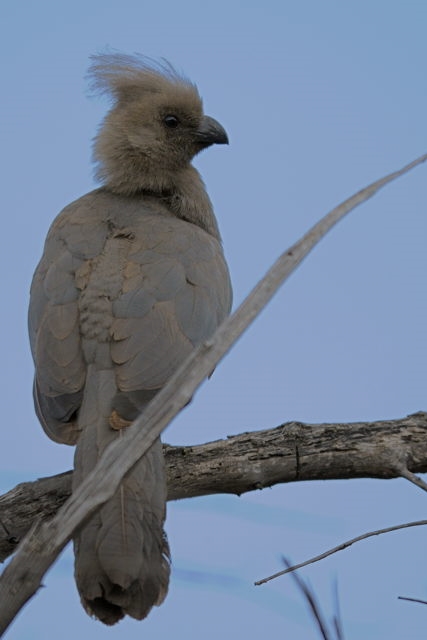 © Dewi
© Dewi
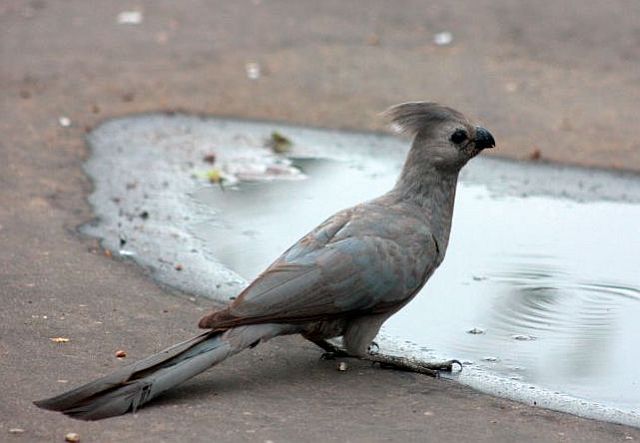 © harrys
© harrys
 © Pumbaa
© Pumbaa
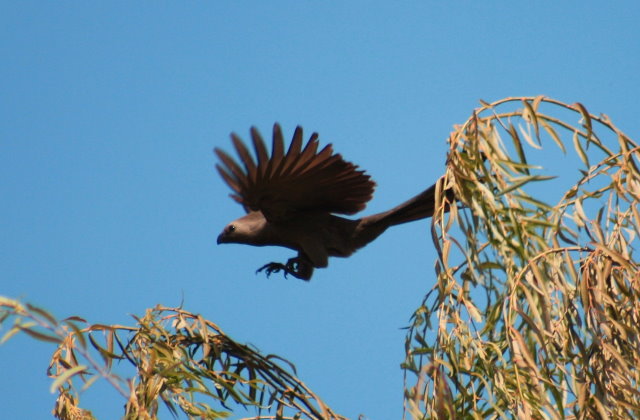 © Flutterby
© Flutterby
 © Kesheshe
© Kesheshe
Etosha National Park, Namibia
Links:
Species text Sabap1
Sabap2
 © Dewi
© Dewi © harrys
© harrys © Pumbaa
© Pumbaa  © Flutterby
© Flutterby © Kesheshe
© KeshesheEtosha National Park, Namibia
Links:
Species text Sabap1
Sabap2
ORDER CUCULIFORMES
The order Cuculiformes, in addition to the cuckoos, traditionally also includes the turacos (family Musophagidae, now treated as a separate order, Musophagiformes). Some zoologists and taxonomists have also included the unique Hoatzin in the Cuculiformes, but its taxonomy remains in dispute. The cuckoo family, in addition to those species named as such, also includes the roadrunners, koels, malkohas, couas, coucals and anis. The coucals and anis are sometimes separated as distinct families, the Centropodidae and Crotophagidae respectively.
There are approximately 140-150 birds in the Cuculidae family, depending on how different species are categorized. This is a diverse grouping of birds and cuckoos or related species are found on every continent except Antarctica, typically in tropical or forested habitats, though some are found in drier regions. No cuckoos are found in the harshest Arctic regions or in the world's most barren deserts, including in northern Africa, the Middle East or in southwestern South America, though migrants or vagrants may be recorded in those areas.
Though there is much variation among these birds, characteristics shared by many Cuculidae species include:
Relatively slender build, often with a very long tail
Brood parasite reproductive habits, though not all are brood parasites
Generally shy and secretive, but often seen sunning
Typically similar plumage between males and females, though genders may differ in size or calls.
The subfamily Cuculinae are the brood-parasitic cuckoos of the Old World. They tend to conform to the classic shape, with (usually) long tails, short legs, long narrow wings and an arboreal lifestyle. The subfamily Phaenicophaeinae are the non-parasitic cuckoos of the Old World, and include the couas, malkohas, and ground-cuckoos. They are more terrestrial cuckoos, with strong and often long legs and short rounded wings. The subfamily typically has brighter plumage and brightly coloured bare skin around the eye. The coucals are another terrestrial subfamily of long tailed long legged and short winged cuckoos. They are large heavyset birds.
The cuckoos are an extremely diverse group of birds with regards to breeding systems. The majority of species are monogamous, but there are exceptions. Polyandry has been confirmed in the African Black Coucal and is suspected to occur in the other coucals, perhaps explaining the reversed sexual dimorphism in the group. The majority of cuckoo species, including malkohas, couas, coucals, and roadrunners and most other American cuckoos, build their own nests, although a large minority engage in brood parasitism. Most of these species nest in trees or bushes, but the coucals lay their eggs in nests on the ground or in low shrubs. Though on some occasions non-parasitic cuckoos parasitize other species, the parent still helps feed the chick.
Non-parasitic cuckoos, like most other non-passerines, lay white eggs, but many of the parasitic species lay coloured eggs to match those of their passerine hosts.
The young of all species are altricial. Non-parasitic cuckoos leave the nest before they can fly, and some New World species have the shortest incubation periods among birds.
About 56 of the Old World species are brood parasites, laying their eggs in the nests of other birds. These species are obligate brood parasites, meaning that they only reproduce in this fashion. In addition to the above noted species, yet others sometimes engage in non-obligate brood parasitism, laying their eggs in the nests of members of their own species in addition to raising their own young. The best-known example is the European Common Cuckoo. The shells of the eggs of brood-parasites are usually thick. They have two distinct layers with an outer chalky layer that is believed to provide resistance to cracking when the eggs are dropped in the host nest. The cuckoo egg hatches earlier than the host's, and the cuckoo chick grows faster; in most cases the chick evicts the eggs or young of the host species. The chick has no time to learn this behavior, so it must be an instinct passed on genetically. The chick encourages the host to keep pace with its high growth rate with its rapid begging call and the chick's open mouth which serves as a sign stimulus.
Cuckoos have evolved various strategies for getting their egg into a host nest. Different species use different strategies based on host defensive strategies. Female cuckoos have evolved secretive and fast laying behaviors, but in some cases, males have been shown to lure host adults away from their nests so that the female can lay her egg in the nest. Some host species may try to directly prevent cuckoos laying eggs in their nest in the first place – birds whose nests are at high risk of cuckoo-contamination are known to mob cuckoos to drive them out of the area.
Female parasitic cuckoos sometimes specialize and lay eggs that closely resemble the eggs of their chosen host. This has been produced by natural selection, as some birds are able to distinguish cuckoo eggs from their own, leading to those eggs least like the host's being thrown out of the nest. Parasitic cuckoos that show the highest levels of egg mimicry are those whose hosts exhibit high levels of egg rejection behavior. Some hosts do not exhibit egg rejection behavior and the cuckoo eggs look very dissimilar from the host eggs. Other species of cuckoo lay "cryptic" eggs, which are dark in color when their hosts' eggs are light. This is a trick to hide the egg from the host, and has evolved in cuckoos that parasitize hosts with dark, domed nests. Some adult parasitic cuckoos completely destroy the host's clutch if they reject the cuckoo egg. In this case, raising the cuckoo chick is less of a cost than the alternative—total clutch destruction.
There are approximately 140-150 birds in the Cuculidae family, depending on how different species are categorized. This is a diverse grouping of birds and cuckoos or related species are found on every continent except Antarctica, typically in tropical or forested habitats, though some are found in drier regions. No cuckoos are found in the harshest Arctic regions or in the world's most barren deserts, including in northern Africa, the Middle East or in southwestern South America, though migrants or vagrants may be recorded in those areas.
Though there is much variation among these birds, characteristics shared by many Cuculidae species include:
Relatively slender build, often with a very long tail
Brood parasite reproductive habits, though not all are brood parasites
Generally shy and secretive, but often seen sunning
Typically similar plumage between males and females, though genders may differ in size or calls.
The subfamily Cuculinae are the brood-parasitic cuckoos of the Old World. They tend to conform to the classic shape, with (usually) long tails, short legs, long narrow wings and an arboreal lifestyle. The subfamily Phaenicophaeinae are the non-parasitic cuckoos of the Old World, and include the couas, malkohas, and ground-cuckoos. They are more terrestrial cuckoos, with strong and often long legs and short rounded wings. The subfamily typically has brighter plumage and brightly coloured bare skin around the eye. The coucals are another terrestrial subfamily of long tailed long legged and short winged cuckoos. They are large heavyset birds.
The cuckoos are an extremely diverse group of birds with regards to breeding systems. The majority of species are monogamous, but there are exceptions. Polyandry has been confirmed in the African Black Coucal and is suspected to occur in the other coucals, perhaps explaining the reversed sexual dimorphism in the group. The majority of cuckoo species, including malkohas, couas, coucals, and roadrunners and most other American cuckoos, build their own nests, although a large minority engage in brood parasitism. Most of these species nest in trees or bushes, but the coucals lay their eggs in nests on the ground or in low shrubs. Though on some occasions non-parasitic cuckoos parasitize other species, the parent still helps feed the chick.
Non-parasitic cuckoos, like most other non-passerines, lay white eggs, but many of the parasitic species lay coloured eggs to match those of their passerine hosts.
The young of all species are altricial. Non-parasitic cuckoos leave the nest before they can fly, and some New World species have the shortest incubation periods among birds.
About 56 of the Old World species are brood parasites, laying their eggs in the nests of other birds. These species are obligate brood parasites, meaning that they only reproduce in this fashion. In addition to the above noted species, yet others sometimes engage in non-obligate brood parasitism, laying their eggs in the nests of members of their own species in addition to raising their own young. The best-known example is the European Common Cuckoo. The shells of the eggs of brood-parasites are usually thick. They have two distinct layers with an outer chalky layer that is believed to provide resistance to cracking when the eggs are dropped in the host nest. The cuckoo egg hatches earlier than the host's, and the cuckoo chick grows faster; in most cases the chick evicts the eggs or young of the host species. The chick has no time to learn this behavior, so it must be an instinct passed on genetically. The chick encourages the host to keep pace with its high growth rate with its rapid begging call and the chick's open mouth which serves as a sign stimulus.
Cuckoos have evolved various strategies for getting their egg into a host nest. Different species use different strategies based on host defensive strategies. Female cuckoos have evolved secretive and fast laying behaviors, but in some cases, males have been shown to lure host adults away from their nests so that the female can lay her egg in the nest. Some host species may try to directly prevent cuckoos laying eggs in their nest in the first place – birds whose nests are at high risk of cuckoo-contamination are known to mob cuckoos to drive them out of the area.
Female parasitic cuckoos sometimes specialize and lay eggs that closely resemble the eggs of their chosen host. This has been produced by natural selection, as some birds are able to distinguish cuckoo eggs from their own, leading to those eggs least like the host's being thrown out of the nest. Parasitic cuckoos that show the highest levels of egg mimicry are those whose hosts exhibit high levels of egg rejection behavior. Some hosts do not exhibit egg rejection behavior and the cuckoo eggs look very dissimilar from the host eggs. Other species of cuckoo lay "cryptic" eggs, which are dark in color when their hosts' eggs are light. This is a trick to hide the egg from the host, and has evolved in cuckoos that parasitize hosts with dark, domed nests. Some adult parasitic cuckoos completely destroy the host's clutch if they reject the cuckoo egg. In this case, raising the cuckoo chick is less of a cost than the alternative—total clutch destruction.
Family Cuculidae (Cuckoos) Index
ORDER CUCULIFORMES
Family Cuculidae (Cuckoos)
Centropus senegalensis Senegal Coucal 390
Centropus cupreicaudus Coppery-tailed 389
Centropus superciliosus White-browed Coucal 391
Centropus burchellii Burchell's Coucal 391
Centropus grillii Black Coucal 388
Ceuthmochares aereus Blue Malkoha
Ceuthmochares australis Green Malkoha 387
Clamator glandarius Great Spotted Cuckoo 380
Clamator levaillantii Levaillant's Cuckoo 381
Clamator jacobinus Jacobin Cuckoo 382
Pachycoccyx audeberti Thick-billed Cuckoo 383
Chrysococcyx caprius Diderick Cuckoo 386
Chrysococcyx klaas Klaas's Cuckoo 385
Chrysococcyx cupreus African Emerald Cuckoo 384
Cercococcyx montanus Barred Long-tailed Cuckoo 379
Cuculus clamosus Black Cuckoo 378
Cuculus solitarius Red-chested Cuckoo 377
Cuculus poliocephalus Lesser Cuckoo 376
Cuculus rochii Madagascar Cuckoo
Cuculus gularis African Cuckoo 375
Cuculus canorus Common Cuckoo 374
Family Cuculidae (Cuckoos)
Centropus senegalensis Senegal Coucal 390
Centropus cupreicaudus Coppery-tailed 389
Centropus superciliosus White-browed Coucal 391
Centropus burchellii Burchell's Coucal 391
Centropus grillii Black Coucal 388
Ceuthmochares aereus Blue Malkoha
Ceuthmochares australis Green Malkoha 387
Clamator glandarius Great Spotted Cuckoo 380
Clamator levaillantii Levaillant's Cuckoo 381
Clamator jacobinus Jacobin Cuckoo 382
Pachycoccyx audeberti Thick-billed Cuckoo 383
Chrysococcyx caprius Diderick Cuckoo 386
Chrysococcyx klaas Klaas's Cuckoo 385
Chrysococcyx cupreus African Emerald Cuckoo 384
Cercococcyx montanus Barred Long-tailed Cuckoo 379
Cuculus clamosus Black Cuckoo 378
Cuculus solitarius Red-chested Cuckoo 377
Cuculus poliocephalus Lesser Cuckoo 376
Cuculus rochii Madagascar Cuckoo
Cuculus gularis African Cuckoo 375
Cuculus canorus Common Cuckoo 374



 © Dewi
© Dewi